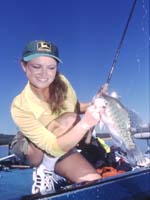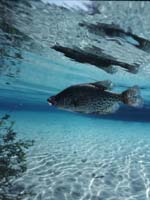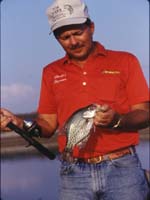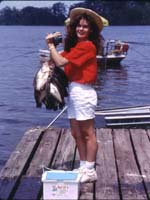
|
Features
|
|
|
|
Book Selections
|
|
Fun & Games
|
|
Contact Us
|
Pay Attention To Your Surroundings, and Use Unusual Techniques To Take Crappie
 Search
for a crappie hotspots during the post-spawn and the prespawn on invisible
treetops under the water. Look for holes in the bank where an old tree
may have blown over during a storm. From the size of the hole on the bank,
you can determine the size of the tree that once stood in that spot. Also
look at other trees on the bank close to the hole. Imagine if the wind
blows them over where their tops will land in relation to where they now
stand on the bank. Using this strategy, you may locate underwater treetops
that hold crappie for which no other angler ever has fished.
Search
for a crappie hotspots during the post-spawn and the prespawn on invisible
treetops under the water. Look for holes in the bank where an old tree
may have blown over during a storm. From the size of the hole on the bank,
you can determine the size of the tree that once stood in that spot. Also
look at other trees on the bank close to the hole. Imagine if the wind
blows them over where their tops will land in relation to where they now
stand on the bank. Using this strategy, you may locate underwater treetops
that hold crappie for which no other angler ever has fished.
Brush shelters will attract and hold crappie. Some of the most effective places where you can sink brush include:
* out in the middle of a bay off a main river channel,
* 30 to 50 yards out from a mud or clay bank,
* on the backside of a bridge or a railroad trestle piling,
* in the middle of open water 200 yards from the nearest bank,
* out on the very end of a long point or
* on the edge of a creek channel out in the middle of a lake.
 An
unusual way to fish for crappie that I learned from northern anglers is
to tip a 1/32-ounce jig with a live, Eurolarva (maggot). Fish the jig
and the maggot on 4-pound test line where you find standing timber on
the edges of underwater creek channels or in small creeks that home deep
eddy pools close to the bank. Let the Eurolarva and jig free-fall to the
bottom, and watch your line for the bite.
An
unusual way to fish for crappie that I learned from northern anglers is
to tip a 1/32-ounce jig with a live, Eurolarva (maggot). Fish the jig
and the maggot on 4-pound test line where you find standing timber on
the edges of underwater creek channels or in small creeks that home deep
eddy pools close to the bank. Let the Eurolarva and jig free-fall to the
bottom, and watch your line for the bite.
Some crappie fishermen go to unusually great lengths to identify crappie hotspots on lakes across the nation. They'll pick a day with relatively clear water. Then they'll either hire a scuba diver or use their own scuba gear to swim along the edges of the bank looking for underwater sunken cover holding crappie that no one else has found. When scuba diving for crappie, I've located numbers of hot-weather summertime crappie honeyholes underwater along the edges of sheer rock bluffs. Often I'll pinpoint underwater caves, deep boulders or logs and brush on the edge of the bluff where crappie will hold. After I've dived in the area, I'll come back to the surface and later fish those spots I've identified as post-spawn hotspots.
 When
you fish for deep crappie in the summer months, use florescent line and
a light jig. Cast the jig out, and watch your line as it free-falls to
the bottom. If the line stops before it hits the bottom or twitches as
it falls, set the hook because the crappie has taken the bait.
When
you fish for deep crappie in the summer months, use florescent line and
a light jig. Cast the jig out, and watch your line as it free-falls to
the bottom. If the line stops before it hits the bottom or twitches as
it falls, set the hook because the crappie has taken the bait.
To learn more about crappie fishing, go to Night Hawk Publications' Home Page, and click on fishing books.
 TOMORROW:
SMALL THINGS MAKE THE DIFFERENCE IN SUCCESS FOR POST-SPAWN CRAPPIE
TOMORROW:
SMALL THINGS MAKE THE DIFFERENCE IN SUCCESS FOR POST-SPAWN CRAPPIE
Check back each day this week for more about Tips For Catching Post-Spawn Crappie ...
Day 1 -Be
Versatile
Day 2 -Vary Your Tactics To Take Post-Spawn
Crappie
Day 3 -Get Ideas From your Fishing Buddies
Day 4 -Pay Attention To Your Surroundings,
and Use Unusual Techniques To Take Crappie
Day 5 -Small Things Make The Difference
In Success for Post-Spawn Crappie